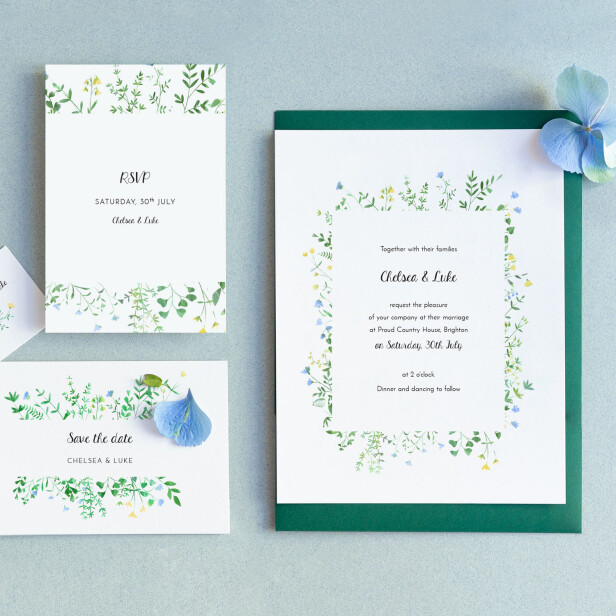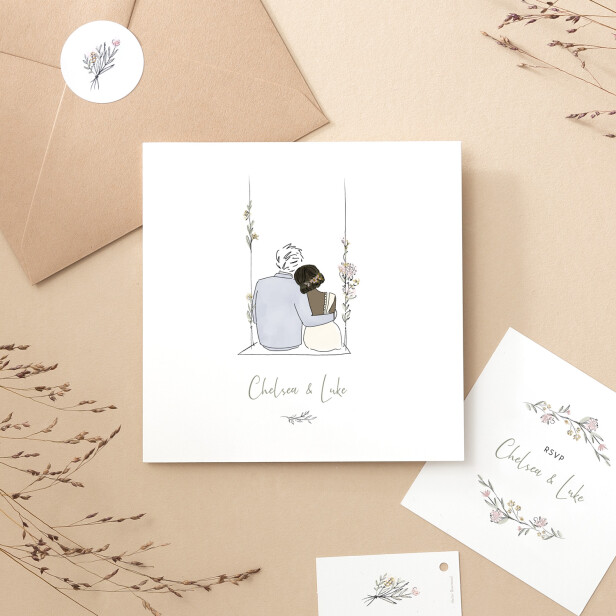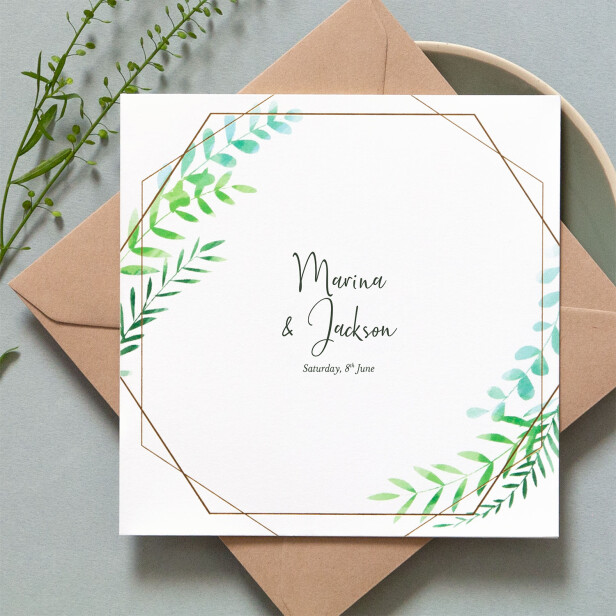- Wording advice
- Save The Date Wording
- Christmas Card Verses 2023
- Business Christmas Card Messages 2023
- Christmas Card Messages 2023 +
- Wedding Invitation Wording -
- Change the Date Wording
- RSVP Wording
- Writing Your Wedding Order of Service
- Wedding Thank You Card Wording
- Baby Thank You Card Wording
- Baby Shower Invitation Wording
- Baby Announcement Wording
- Christening Invitation Wording
- Communion Invitation Wording
- Writing Your Christening Order Of Service
- Kids Party Invitation Wording
- Party Invitation Wording
- Wording Your Personalised Note Cards
Wedding invitation wording
Take a look at our helpful advice on what to include as part of your wedding invitation wording. You can then head over to our traditional wedding invitation wording page or our informal wedding invitation wording page for example texts for your invites. We even have a guide to wording your evening wedding invitations if you have guests that are only invited to part of your wedding celebrations, as well as wording suggestions that take the current pandemic into account.
What information do I need to include on my wedding invitations?
If you still aren’t sure how to format your wedding invitations and are looking for ideas for your wedding invitation wording, then here is a list of what to include on your invites:
- Names of the happy couple
- Date and time of the ceremony and reception
- Names of the wedding venues
- RSVP contact details
- RSVP deadline
You may also wish to add your guests’ names to make it clear whether partners and children are invited, so this can be done by hand. Add a space for the names to your wedding invitations or even a dotted line.
If you are inviting all your guests to all parts of the festivities then you can go ahead and include this information directly on your invitations, however, if some guests are invited only to the evening reception then we would recommend creating separate evening wedding invitations. Similarly, if the coronavirus pandemic has affected the size of your guest list, you can create separate invites for the small number who are invited to attend the ceremony and those who are invited to view the livestream of the wedding then attend a larger celebration at a later date.
We would also recommend that you use our guest information cards to include all the finer details such as directions to your venues, accommodation options, gift list information etc. This will allow you to free up space on your wedding invites and to make sure that your guests have all the information they need to arrive at the wedding on time!
Typical layout for wedding invitations
1) Host line
- This is the line that denotes who is hosting, (or paying for), the wedding so will either feature the names of the future bride and groom or include one or both sets of parents.
3) Names of the happy couple
- The bride’s name should come before that of the groom.
- For traditional invitations, it is more common to include full names whilst more informal wedding invitations can feature only the first names of the happy couple.
5) Venue
- Usually, you do not include the full address of the wedding venue and would instead simply add the name of the venue with reference to the town or county.
- You can always add the full address on your guest information cards when giving directions to the venue.
7) Covid-19 guidelines
- You may wish to reassure your guests that your wedding ceremony and reception will be held in adherence with the latest government guidelines related to the coronavirus pandemic and that you will let your guests know if the date or nature of your wedding must be changed in any way.
2) Request phrase
- You will then need to add a line asking your guests to attend your wedding such as “request the honour of your presence” (typically indicating a religious ceremony), or “request the pleasure of your company” (typically indicating a civil ceremony).
- If the bride’s parents are hosting then this line would read “request the honour of your presence at the marriage of their daughter...to....”, whilst if both sets of parents are hosting this should read “at the marriage of their children” followed by the names of the bride and groom.
4) Date and Time
- Include the day of the week and the year when adding the date to your wedding invitations. Take a look below for grammar tips on how to write the time and date.
6) Reception information
- You can add your wedding reception information directly to your invitations for those attending both the ceremony and the reception, or create separate evening wedding invitations for those only adding the evening reception.
- For the main wedding invitations, you can simply add “and afterwards at the reception” or “followed by a reception”, if your reception is in the same place as your ceremony.
- If your reception is held at a different venue then you will need to add the location of the new venue on a separate line.
Tips for your wedding invitation wording
If you still need some more hints and tips to find the perfect wedding invitation wording, then here a few grammar tips that will help you create flawless invitations. We are also here to help thanks to our complimentary retouching service. Your wedding invitations will be checked over by our talented proofreaders to make sure that there are no spelling mistakes and we may suggest alternative wording where necessary. These tips are based on errors commonly seen by our proofreaders!
How to present the names of the happy couple or that of their parents on your wedding invitations
- The bride’s name usually comes before that of the groom
- Always include the titles and first names of parents, mentioned on your wedding invitations.
- If the bride's’ parents are hosting the wedding then the bride’s first and middle name will follow the phrase “to the wedding of their daughter…” The groom’s full name will then follow, preceded by “to”.
- In British English, a full stop is not required after titles.
- Take a look at our traditional and informal wedding invitation wording to see examples of how to present the names of the happy couple and their parents, with variations for divorced or deceased parents.
How to write the date on your wedding invitations
- British Format: Day Month Year (with a th, st or rd attached to the day).
- American Format: Month Day, Year (without a th, st or rd attached to the day).
- We would recommend including the day of the week and the year on your wedding invitations laying them out like this: On Saturday, 16th August 2025.
- The th, st or rd of the date should be in superscript but this cannot always be added via our editing tool, so our graphic designers will adjust the date appropriately.
- If you would like to write out the date in words then only the day of the week and the month should be in capital letters e.g. On Saturday, the sixteenth of August two thousand and twenty-five.
How to write the time on your wedding invitations
- Writing out the time in words: this is the most traditional way to write the time on wedding invitations and will need to include reference to the morning or the afternoon. For example: at two o’clock in the afternoon.
- Writing out the time in numbers: separate the hours and minutes by a full stop or a colon. You will then need to add am or pm leaving a space after the minutes. For example: at 2:00 pm.
- Writing out the time in the twenty-four-hour clock: you do not need to include am/pm with times in the twenty for hour clock.
How to present your contact details on your wedding invitations
- Separate phone numbers into blocks of two or three numbers to make them easier to follow.
- If all of the elements of your address are separated by single lines then you do not need to add commas to the end of each line.
- If your address is written across one line the commas are required between the house name, road, town and county.
- No comma is required between the county and the postcode.
How to write your wedding invitations in the first or third person
- For more traditional wedding invitation wording use the third person, for example, “Chelsea Daniels and Aaron Harrison invite you to their wedding” or “...request the pleasure of your company at their marriage”.
- For more informal wedding invitation wording you may like to use the first person “We, Chelsea and Aaron, invite you to our wedding.
Common spelling errors to look out for on wedding invitations
-
Don’t forget the “a” in “dietary” when asking your guests for their “dietary requirements”
-
Remember that “Accommodation” has two c’s and two m’s




.jpg)